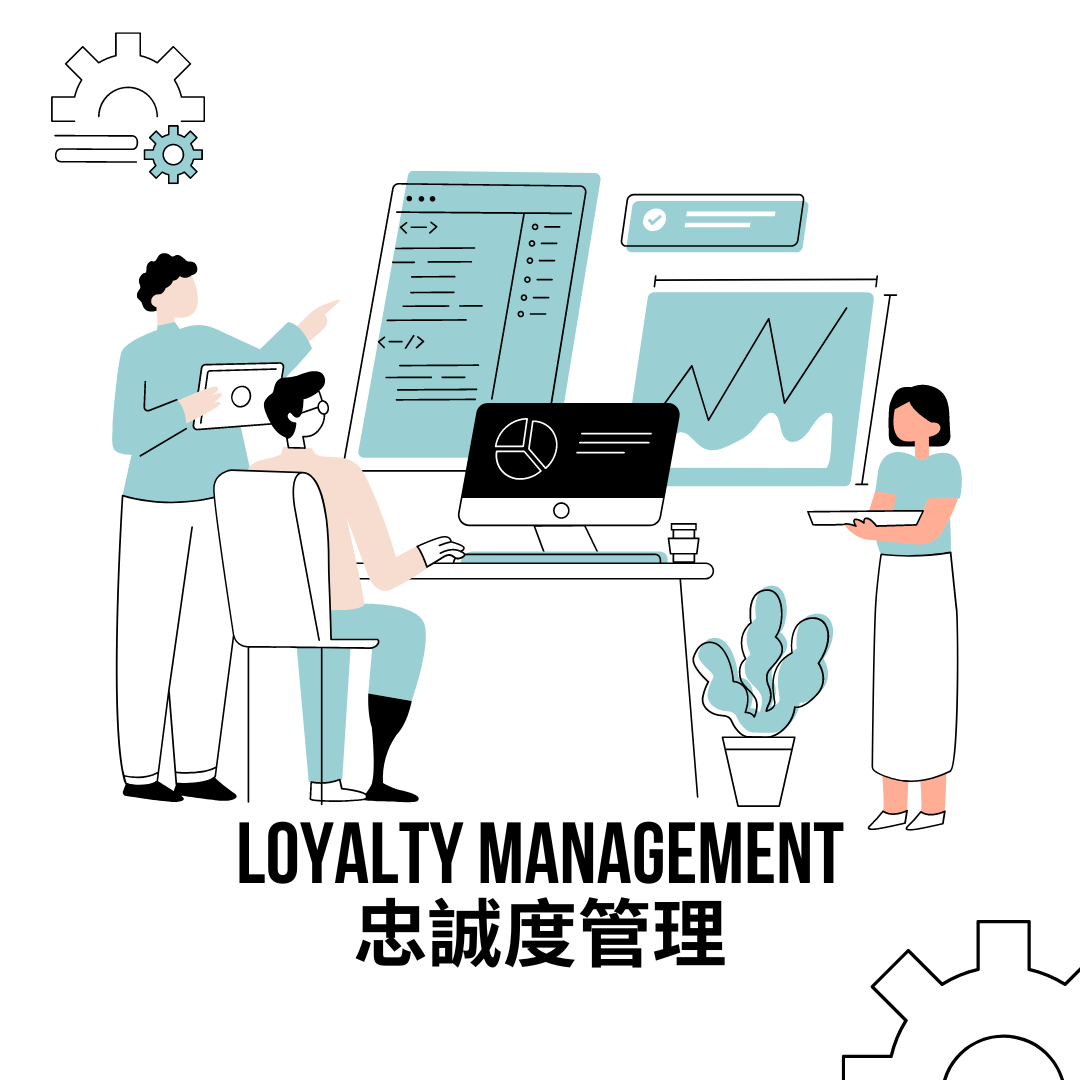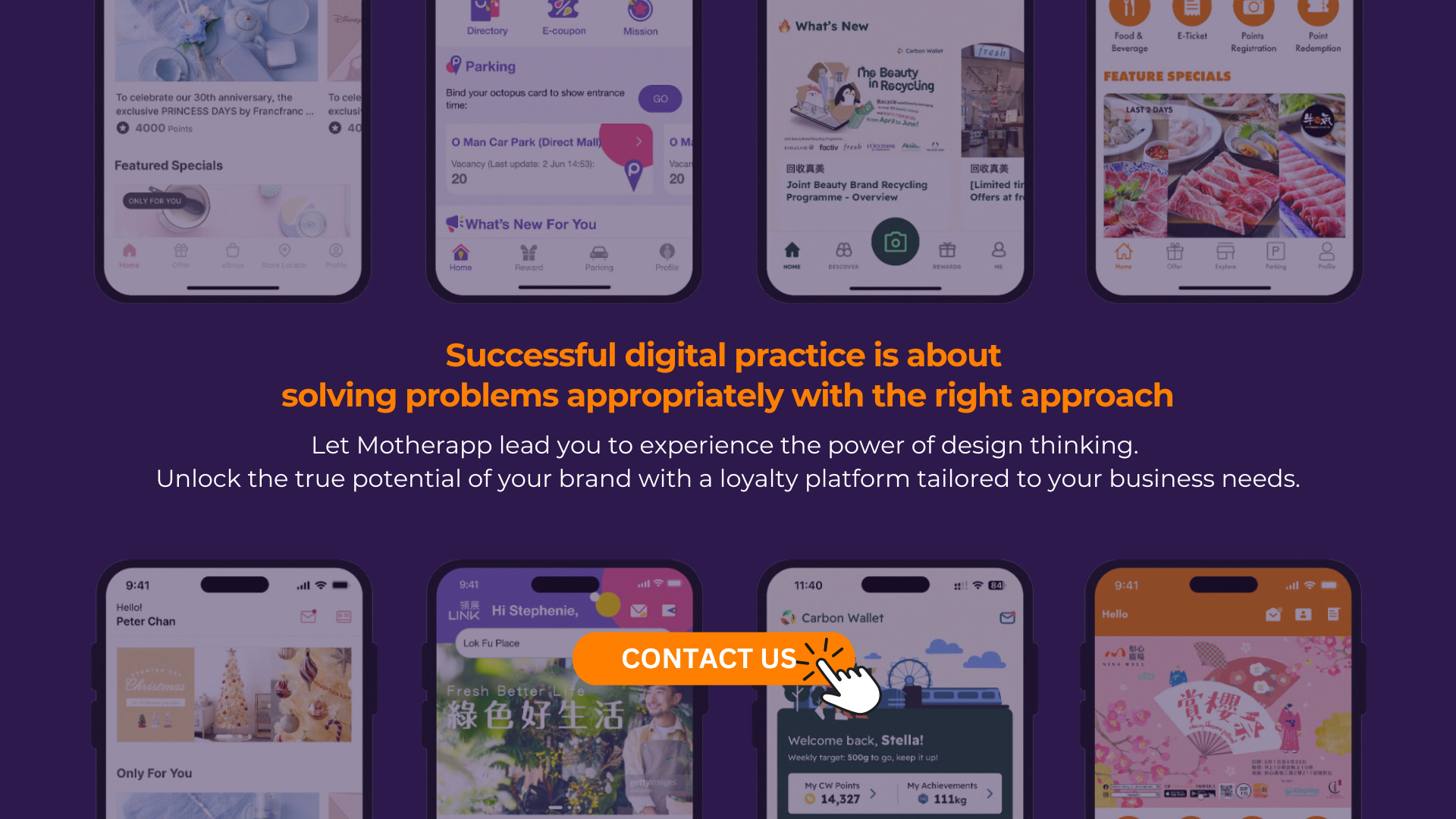4 Essential Loyalty Management Techniques to Boost Customer Loyalty
Attracting a new customer costs significantly more than retaining an existing one, prompting many brands to launch loyalty reward programs to maintain and strengthen customer loyalty. Today, nearly 90% of businesses have implemented or have had reward programs, but the real challenge lies in management—keeping customers actively engaged in these programs.
The key to success is the consistency and continual optimization of the program, considering the unpredictable trends in customer shopping behavior and market conditions. Skillfully monitoring both short-term and long-term activities within loyalty programs can lead to brand success. This article will delve into the fundamental concepts of loyalty management and introduce four effective practical techniques to help businesses establish and operate successful loyalty programs.
What is Loyalty Program Management?
Loyalty management is a strategic approach that engages customers by consistently offering a variety of rewards, incentives, and personalized experiences. It involves using data analysis and customer segmentation to create targeted marketing campaigns that foster long-term relationships and repeat purchases. The goal is to enhance the Customer Lifetime Value (CLV) to maximize profits.
Read more: Repeat customers: Definition, Rates & Strategies| Keep Your Customers Coming Back
Common Types of Loyalty Programs
Point-Based Loyalty Programs
Point-based loyalty programs are one of the most common loyalty strategies. Customers accumulate points through purchases of goods or services, which can then be exchanged for prizes or discounts. This method is simple and easy to understand and effectively motivates repeat purchasing behavior.
Implementation Strategies:
- Set reasonable rules for earning and redeeming points to ensure customers feel valued.
- Offer a variety of redemption options to meet the needs and preferences of different customers.
- Regularly hold points events and promotions to stimulate customer participation.
Tiered Loyalty Programs
Tiered loyalty programs are a structured customer loyalty strategy that categorizes customers into different levels based on their spending amount or engagement. Each level offers different rewards and privileges, and as customers upgrade to higher levels, they receive more attractive benefits. The ultimate goal is to stimulate customer spending through tiering, enhancing each customer’s transaction frequency and total spending, thereby achieving a higher Customer Lifetime Value.
Implementation Strategies:
- Set clear tier standards, ensuring that transitions between levels are feasible and appealing.
- Enhance customer spending motivation through tiered rewards.
- Level Up: Attract customers to spend more by offering exclusive privileges such as priority shopping rights and special discounts available to higher-tier members.
- Level Retention: Use level retention conditions such as minimum annual spending or number of transactions to stimulate ongoing customer spending.
- Regularly assess and adjust levels and rewards to ensure the program remains attractive.
Read more: Tiered Rewards: Encouraging Long-term Loyalty in Retail
Value-Based Loyalty Programs
Value-based loyalty programs aim to create deeper customer connections, encouraging not only purchasing behavior but also brand advocacy and engagement, such as valuing customer shares and brand recommendations on social media.
Implementation Strategies:
- Design a diverse reward mechanism that extends beyond just shopping points, incorporating exclusive member activities both offline (such as limited-time check-ins) and online (such as social media sharing rewards).
- Use data analysis to identify high-value customers and offer them targeted exclusive discounts and experiences.
- Establish a brand community that allows customers to interact and share their brand stories, enhancing brand loyalty.
Four Effective Techniques for Managing Customer Loyalty
I. Clear Goals, Step by Step
In loyalty management, setting clear and specific goals is the cornerstone of success. Initially, companies should clarify their long-term and short-term business objectives, which should closely align with the design of the loyalty program. For instance, increasing retention rates, boosting the average spending amount, enhancing customer lifetime value (CLV), or promoting sales of new products.
Brands might consider using the SMART goals framework to set several specific, measurable, achievable, relevant, and time-bound loyalty program objectives. For example, if the ultimate aim is to enhance customer CLV, setting the current target CLV as the requirement for current tier advancement can be an effective strategy. From the member’s perspective, tier advancement brings more exclusive rights; from the brand’s perspective, using tier advancement criteria facilitates easy management of CLV while making reaching CLV goals more appealing.
Implementing a loyalty program step-by-step can help employees and customers gradually adapt to the program’s various features and adjust its details according to the situation. Brands can gradually introduce features in their loyalty program app, starting with basic points collection and usage, and later adding personalized promotions and integration with external partners, thus continuously improving the app.
During the pilot phase, companies should closely monitor metrics such as new member numbers, points issuance and redemption, and customer engagement. This data helps companies understand how the program operates and customer reactions, allowing for targeted optimizations. For example, if certain rewards are met with lackluster response, consider adjusting the rewards or improving promotional methods.
Based on feedback from the pilot phase, make necessary adjustments. The data and experiences gained from the pilot can help refine the loyalty program, making it more attractive and operational. Not only does the pilot phase test market and customer reactions, but it also accelerates deployment, quickly bringing the app into service.
In the expansion process, companies should continue to monitor and analyze data to ensure the loyalty program consistently meets its goals and adapts to market changes and customer needs. Ultimately, through gradual implementation and continuous improvement, a company can establish a stable and efficient loyalty management system.
II. Keep It Simple and Understandable
In loyalty management, designing a simple and understandable program is key to increasing customer engagement and satisfaction. Customers are unwilling to spend excessive time and energy understanding complex loyalty programs, so companies should ensure the program’s rules and terms are straightforward. This allows customers to effortlessly understand how to earn and redeem rewards, thus increasing their willingness to participate.
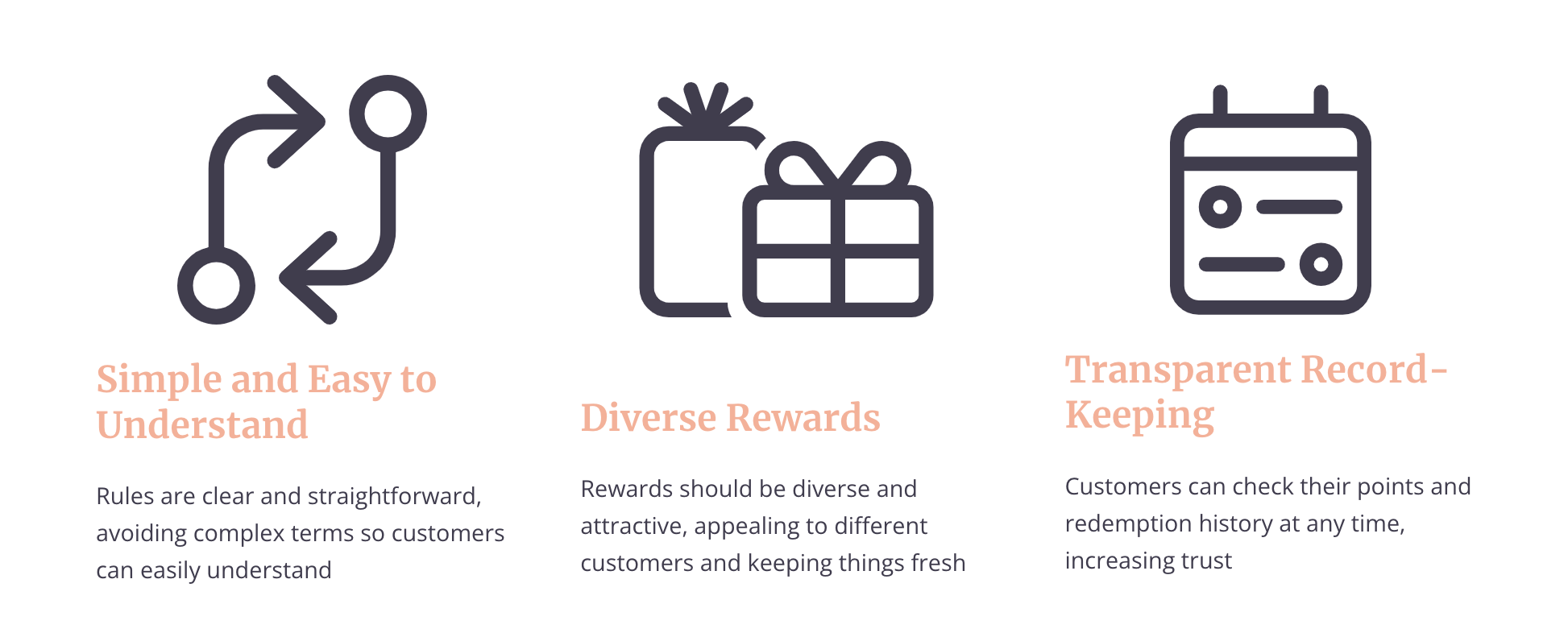
Point Redemption Rules
The rules for using points should be intuitive and easy to understand to facilitate communication with customers. For example, the “points as cash” system allows customers to earn one point for every $1 spent, with every 100 points directly convertible into $1 worth of “eDollar.” Another example is allowing customers to accumulate a certain number of points to redeem for goods or discount coupons. Such simple mechanisms let customers clearly know the rewards they can earn, thereby boosting their engagement. Companies should avoid overly complex terms and conditions to ensure all customers can participate easily without worrying about hidden restrictions.
Diverse Rewards
The rewards in a loyalty program should be diverse and attractive. Different customers have different preferences for rewards, so offering a variety of options can meet the needs of different customers. Besides discounts and free products, options might include VIP experiences, exclusive event invitations, or joint rewards with partners. This can make customers feel more valued and further increase their loyalty.
Transparency in Record Keeping
Brands should also ensure that information about the loyalty program is easily accessible and understandable. This includes providing clear explanations and guidelines on websites, apps, and in physical stores. Employees should also be trained to accurately answer customer questions and provide assistance. This ensures that customers do not encounter difficulties or confusion during their participation in the program, enhancing their willingness and experience.
Read more: What Makes The Point by SHKP a Successful Loyalty Program?
III. Establishing Partnerships to Enhance Rewards
Establishing partnerships is a key strategy for enhancing the attractiveness and value of loyalty programs. Relying solely on a company’s own resources often makes it challenging to offer a diversified and high-value set of rewards. However, collaborating with other brands or corporate partners can significantly enrich the reward offerings and attract more customers to participate.
Choosing the Right Partners
Partners should align with your brand values and target customer demographics to ensure synergistic effects in the joint reward program. For instance, a retailer could partner with entities in the dining, travel, or entertainment sectors, providing customers with cross-industry reward options. This not only increases the diversity and appeal of the rewards but also leverages the brand influence of partners to enhance your own brand’s recognition and reputation.
Synergistic Effects
When designing joint reward programs, it is important to consider the interests of both parties and the needs of customers. This can be achieved by co-developing exclusive products or services, hosting joint events, or offering cross-promotions. For example, airlines and hotel groups can collaborate to offer flight miles redeemable for hotel discounts, satisfying diverse customer needs and promoting business growth for both parties.
Sharing Customer Insights
Through data sharing and analysis with partners, deeper insights into customer behaviors and preferences can be gained, further optimizing the loyalty program. Understanding customers’ spending habits at partner venues can help design more targeted rewards and promotional activities, increasing customer engagement and loyalty.
In conclusion, by establishing strong partnerships, companies can offer richer and more diverse reward options, enhancing the attractiveness and competitiveness of their programs. Partnership also facilitates resource sharing and brand collaboration, improving the market position and commercial value of both partners. Loyalty programs thus evolve from being a marketing tool for a single brand to a strategic platform for multi-party collaboration and mutual benefits.
Read more: What Makes yuu Rewards Club a Successful Loyalty Program?
IV. Monitoring, Analyzing, and Adjusting
A major purpose of implementing a loyalty program is to collect customer behavior data through the program, and then apply these insights to brand promotion and interaction strategies to maximize revenue. Therefore, in loyalty management, continual monitoring, analysis, and adjustment are key to maintaining the effectiveness of the program. Regular monitoring of various indicators, such as the number of new members, points issuance and redemption, customer engagement, etc., can help you understand the operation of the program and customer reactions, thereby allowing for targeted strategic optimizations.
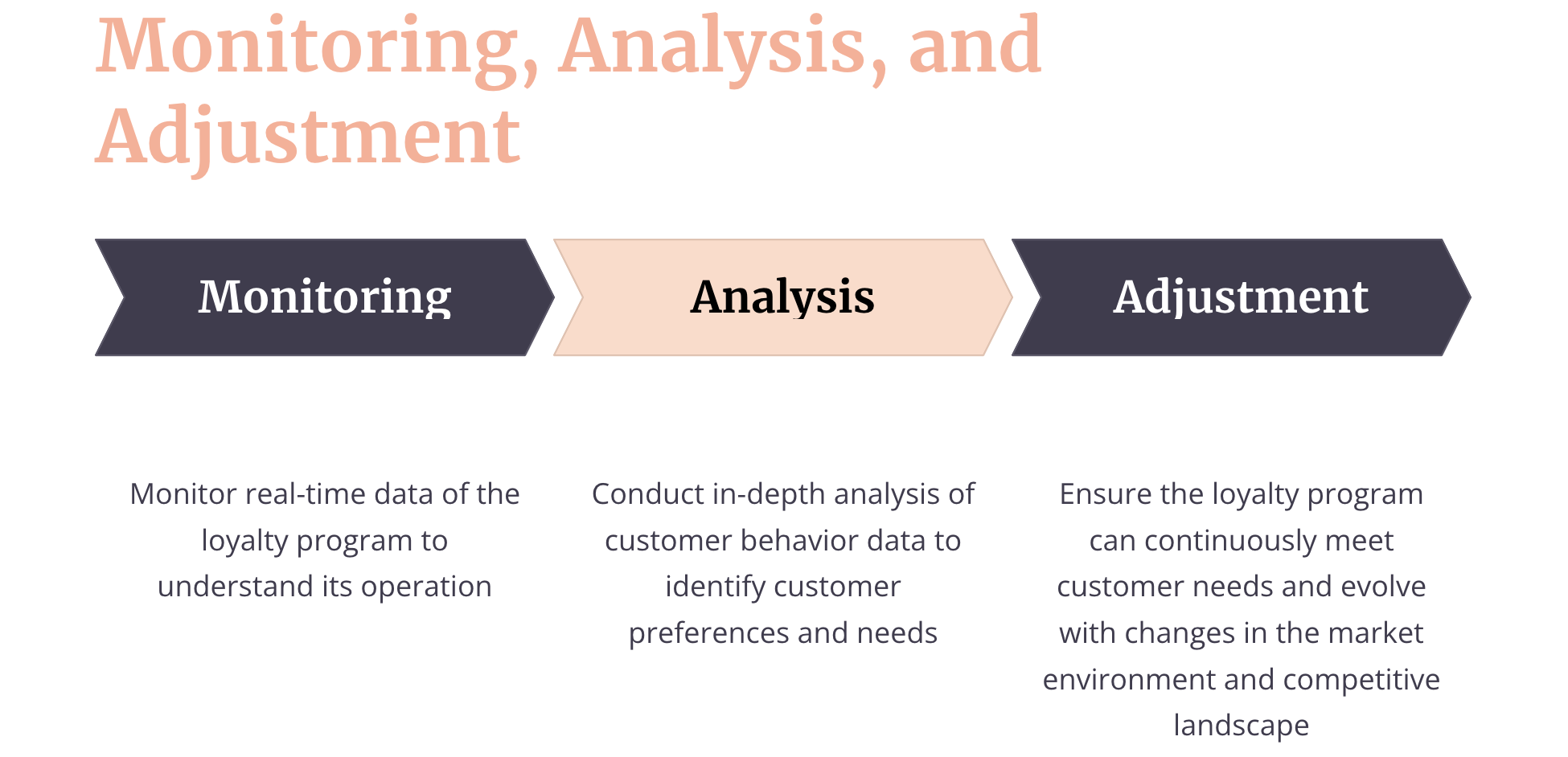
Data Monitoring
Monitor the operation of the loyalty program, including real-time tracking of points accumulation and redemption data, monitoring customer participation, and identifying any anomalies. For example, if a sudden drop in the redemption rate of points is observed over a period, it may indicate that the rewards are not sufficiently attractive and need adjustment. Additionally, brands should regularly review the financial status of the loyalty program to ensure that it operates within budget and delivers the expected return on investment.
Data Analysis
By conducting in-depth analysis of customer behavior data, customer preferences and needs can be identified, allowing for the design of more targeted rewards and promotional activities. Analytical metrics include:
- New Member Numbers: Track the trend of new members joining the program over different periods, identifying peaks and troughs, comparing data from similar periods, tracking new and existing member numbers, and considering holidays or specific days that attract customers, such as seasonal promotions.
- Points Redemption Trends: Compare the number of points used by members during specific periods with the number of points accumulated, estimating the points yet to be used and those already used. Brands should account for unused points as business costs, establishing adequate financial reserves to be prepared for sudden peaks in redemptions, such as during holidays or vacations. Monitoring redemption trends can clearly indicate the current attractiveness of the program and highlight particularly appealing rewards.
- Anomaly Detection: Regularly check transaction records to identify transactions that may have been caused by errors, such as incorrect points addition or deduction, system calculation errors, duplicate records, etc. Regular monitoring not only allows for timely detection and resolution of issues but also system adjustments when necessary. This can improve customer satisfaction while ensuring the accuracy of collected data for more precise analysis and decision-making.
- Customer Participation Frequency and Patterns: By analyzing the frequency of member participation in the loyalty program during different periods, brands can identify high-value loyal customers and potential customer churn. For example, brands can use the existing RFM model to timely identify these customers, allowing for subsequent actions to motivate consumption and retain customers.
Adjusting the Program
Based on the results of monitoring and analysis, making necessary adjustments to the loyalty program is crucial. These adjustments could be minor improvements, such as optimizing the points redemption process or adding new reward options; or they could be larger changes, such as redesigning the structure of the loyalty program or introducing new partners. The goal of adjustments is to ensure that the loyalty program continues to meet customer needs and evolves continuously with changes in the market environment and competitive landscape.
Continual monitoring, analysis, and adjustment not only ensure the effectiveness of the loyalty program but also help enterprises maintain an edge in a competitive market. As market environments and customer needs change, only through continuous improvement and innovation can loyalty programs continue to attract and retain customers. Enterprises should establish a flexible and efficient management mechanism to ensure that the loyalty program can respond quickly to market and customer changes, achieving long-term business growth and brand value enhancement.
Why do we need loyalty management?
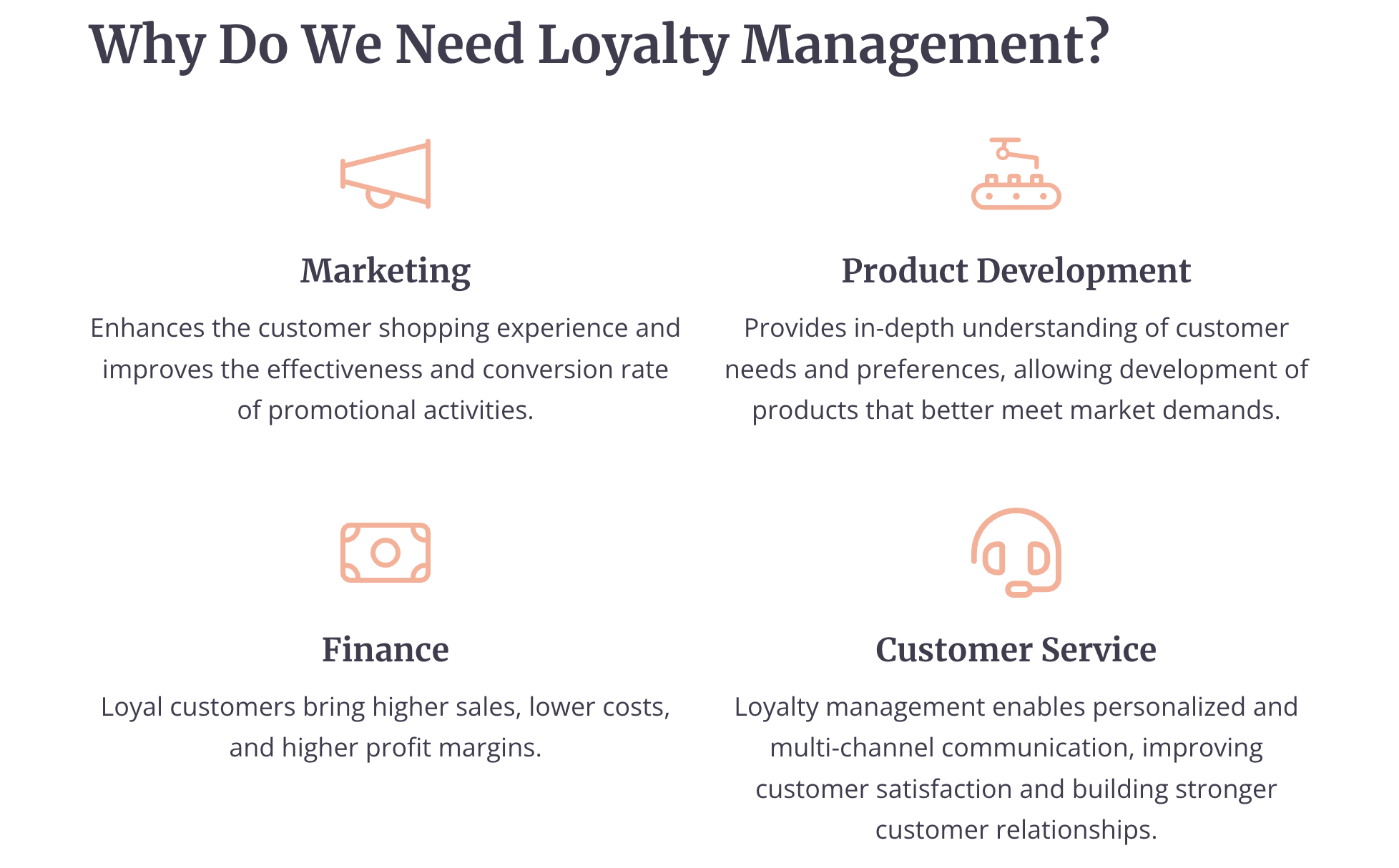
Loyalty management can maintain customer activity through collecting and analyzing insights from loyalty programs, and it positively impacts various aspects of a brand, such as:
Marketing
Effective loyalty management can significantly increase conversion rates and customer loyalty. Through regular promotional activities and personalized promotions, businesses can continuously attract customers’ attention and increase purchase frequency. For example, based on customers’ purchase history and preferences, businesses can send customized promotional messages, which not only enhances the shopping experience but also improves the effectiveness of promotional activities.
Product Development
With data collected through loyalty programs, businesses can gain deep insights into customer needs and preferences, thereby developing products that better meet market demands. This data can also be used for market segmentation and targeted marketing, enhancing the effectiveness of marketing campaigns. For instance, businesses can analyze the purchasing behavior of loyal customers to identify which products or services are most popular, thus optimizing product lines or introducing new products. Additionally, customer feedback and suggestions are crucial for product improvement, allowing businesses to iterate based on this feedback, enhancing product quality and user experience.
Finance
Loyalty management can significantly increase customer retention, thereby enhancing a company’s profitability. Retaining existing customers generally costs less than acquiring new customers, and loyalty programs can help achieve a higher return on investment. Loyal customers often have a higher purchase frequency and average order value, meaning they contribute more to the business. Through loyalty programs, companies can establish a stable source of revenue, reduce sales volatility, and enhance financial stability.
Customer Service
Loyalty management can also improve the customer service experience. By offering personalized support and multi-channel communication, businesses can increase customer satisfaction and build stronger customer relationships. For example, through loyalty programs, businesses can understand each customer’s preferences and historical interactions, thereby providing more accurate and considerate services. Multi-channel support (such as phone, email, online chat, and social media) ensures that customers can conveniently contact the business, quickly resolve issues, and increase customer satisfaction and loyalty.
Summary
Successful loyalty management not only enhances the performance of loyalty programs but also cultivates long-term customer loyalty, increases business revenue, and market competitiveness. Through the following four effective practices—clear objectives, keeping it simple and understandable, establishing partnerships, and ongoing monitoring, analysis, and adjustment—businesses can more effectively attract and retain customers. These strategies help build a stable customer base and enhance customer engagement and satisfaction through innovative and flexible loyalty programs, increasing brand value and securing a firm position in a competitive market.
If your brand is considering implementing or optimizing a loyalty program and wishes to enhance customer experience and loyalty through a professional loyalty management system, we can provide comprehensive loyalty management consulting and a one-stop customer loyalty platform solution. This will help your brand build a strong customer base and maintain a leading position in fierce market competition. Visit our website for more information, or contact our professional team directly for consultation. We will provide you with a tailored loyalty program strategy to help your business achieve long-term development.
THESE ARTICLES MIGHT INTEREST YOU
The Art of User Experience: Why UX/UI is Indispensable in App Development
Building Customer Loyalty Reward Programs: What is it? How does it work? 3 Best Examples in HK
What is CRM? A Complete Guide to Customer Relationship Management Systems – Motherapp
Best Local Loyalty Program Tactics
Maximize Loyalty with Tier-Based Membership
More Case Studies
Carbon Wallet – Different Use of Loyalty Program
Carbon Wallet Rebranding a Green Lifestyle Community
Francfranc FUN! – Loyalty Program for Affordable Luxury
Contact us now for more professional advice and one-on-one consultation.
Keep up with us – follow us on social media!
